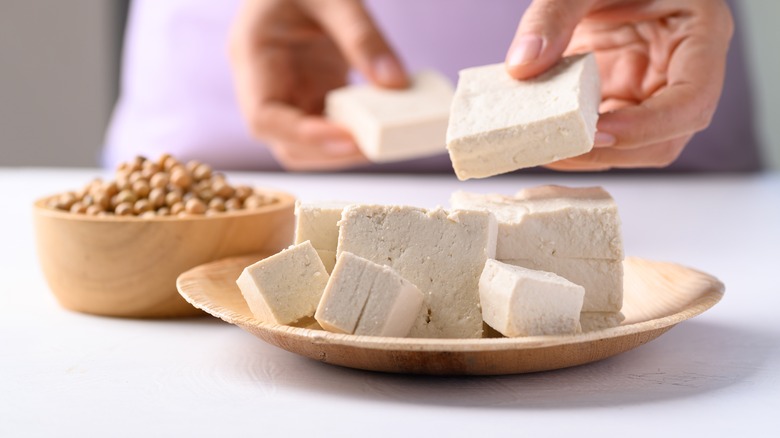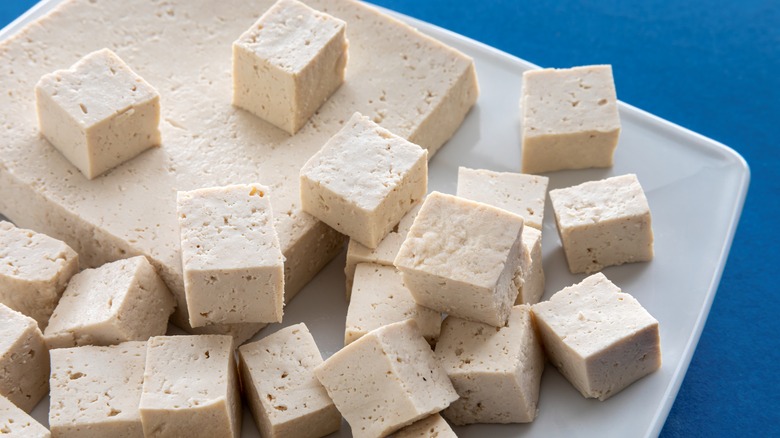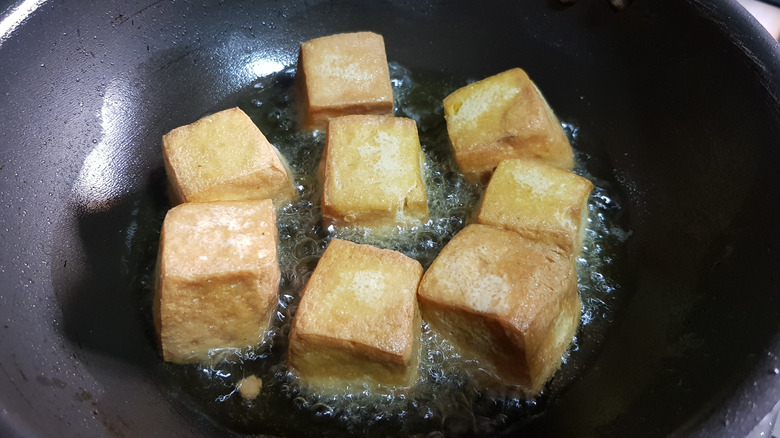How A Cast Iron Skillet Can Help Make Tofu Prep Much Easier
In today's world where meat comes secondary in certain diets, tofu has taken the stage, creating a huge name for itself. Not only is it highly diverse, but it absorbs enormous flavor and acts as a protein for those living a plant-based or vegetarian lifestyle. The texture is a bit spongy, and it holds a lot of water. While some may not prefer tofu due to the texture, with the right preparation, it can be transformed into many different consistencies such as smooth and soft or crispy and crumbly. So what exactly is tofu, and what is the best way to prepare it?
According to the BBC, tofu, a bean curd derived from soya (aka soy), is made similar to dairy cheeses. Basically, a coagulant, such as nagaris or calcium sulfate, is added to soy milk to help it curdle and is then pressed into a solid block and cooled (via TofuBud). However, the difference between tofu and cheese is all in the milk — soy milk is plant-based, whereas cheese is made by curdling and solidifying whole milk. This explains the difference in flavor.
With soybeans grown more abundantly in East Asia, tofu was a part of Asian cuisine long before it gained popularity worldwide, states ThoughtCo. Now that more and more recipes are featuring this meaty substitute, here's a tip for prepping it for cooking.
Press your tofu with a cast iron skillet to release the water
Have you ever found when cooking tofu that the water releases into your dish and dilutes the sauce? It's also easy to get a soggy texture when frying tofu due to not having squeezed out enough water beforehand. According to Bon Appétit, while firmer varieties of tofu already have a good amount of water squeezed out, they still need assistance. Patting dry with a paper towel is an obvious first step, and it will help some — but not quite like placing a heavy weight on top. And that's where a cast iron skillet comes in.
The next time you want super crispy tofu without the risk of mush or sog, try pressing it with a cast iron skillet. Start by placing a kitchen towel on top of a baking sheet, then adding the tofu on top. Next, cover the tofu with another kitchen towel, place a cutting board on top, and then add a cast iron skillet on top of that. You'll want to leave the tofu like this for at least 20 minutes, or up to overnight. You can speed the process further by cutting the tofu before stacking it for pressing. The increased surface area allows more space for water to escape (via Bon Appétit).
Any heavy object will work – if the tofu's firm enough
Not only does this technique accomplish a crispy exterior, but it also prevents tofu from crumbling, keeping the cuts in perfect shape. If you don't have a cast iron skillet, don't fret — this method works with any object similar in weight. Once the liquid has seeped out, The Hidden Veggies recommends coating your cut pieces in cornstarch, which will absorb any leftover water while also giving it a crispy exterior. Lastly, The Hidden Veggies notes it's best to use a nonstick pan for frying. Odds are, when tofu sticks to a pan that isn't nonstick, it won't want to let go. This could lead to some heavy scraping and not-so-pretty tofu pieces. If you intend to use your cast iron skillet, be sure to season it well beforehand.
Now that you've mastered the fine art of tofu frying, it's time to put your skills to the test. Just remember, any type of tofu softer than firm and extra-firm might not hold up when heavy pressure is applied — softer types are best for making vegan sauces or incorporating into stews.


